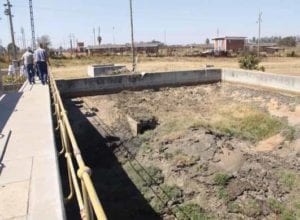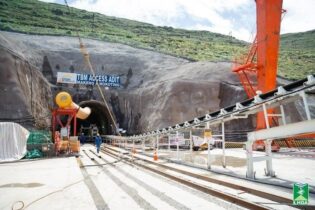By Simon Takawira Muserere
According to Prof Reiko Nakamura of the International Lake Environment Committee (2011), the management and conservation of the world lakes and reservoirs are at a crisis point. Human population is steadily increasing, with more than seven billion people already inhabiting the planet, but the ability of the world lakes and reservoirs to meet the needs of the world’s population is rapidly decreasing, he argues. The global water challenge is not simply about a lack of access to clean sources, it is, in fact, a complex problem that is related to competing demands, climate change and variability, public education and resource management (Columbia Water Center, 2011). It is estimated that by 2015, nearly 3 billion inhabitants, mainly from developing countries, are expected to face water stress to satisfy their food, irrigation, industrial and domestic needs (Ujang and Buckley, 2002). Conclusions were made that the hydrological, engineering and social sciences have important roles to play in enabling African economies to overcome the acute and often devastating water problems confronting them now and in future decades (Oyebande, 2001). The SADC region has prioritised water pollution as it is a pressing issue and the challenge has always been to see how best environmental education can help resolve water pollution among other pressing issues such as HIV and waste management (SADC, 2009). Only 50% of Zimbabwean urban population drink appropriately treated water while only 9.25% from rural areas access safe water (UNICEF, 2012). The current water management challenges in Harare are that wastewater is discharged untreated into Lake Chivero, the city’s raw water source, which is contributing to the lake eutrophication (Nhapi, 2004). According to the National Water Quality Laboratory, wastewater effluent results of 2012 show that Firle sewage works normally operates in the high environmental hazard range in terms of the Environmental Management Act, chapter 20:27 effluent discharge standards. It is believed that Firle sewage works, the largest sewage treatment plant in Harare with a design capacity of 144 000 m3/day and approximately 10 km upstream of the lake, is the major single polluter of Lake Chivero (JICA, 2006). The lake’s total nitrogen load is 190 tpa and the total phosphorus load is 80 tpa and this has caused hypereutrophic conditions in Lake Chivero (ILEC, 2009). In this way the lake serves as a sink for pollutants that are not effectively removed via wastewater treatment or reuse (Nhapi et al., 2006). Drinking water deterioration The water treatment chemical requirements have increased in number and levels of dosage since mid-1990s and the city of Harare currently uses eight water treatment chemicals compared to the two to three generally used by other urban centres in Zimbabwe (Hoko and Makado, 2011). Recent reports from the city of Harare have indicated that US$2 million to US$3 million are now required to procure the eight water treatment chemicals to treat water at Morton Jaffray water works, which is the city’s major water treatment plant. Drinking water quality has deteriorated over time, resulting in customers no longer being satisfied with the quality of water, which has affected customer perceptions and could be contributing to low willingness to pay; the city’s revenue collection efficiency is approximately 60% of the billed amount. Furthermore, due to the poor raw water quality, the water treatment residues have increased in quantity over years. These residues are discharged directly into Manyame River without treatment at a total rate of approximately 108 800 m3/d, which is about 80 to 90% of the 60 to 70 t of alum used each day (Muisa et al., 2011). These residues have affected downstream users and also aquatic life downstream, with the levels of aluminium in fish found to be over 100 times the threshold for human consumption suggested by the World Health Organization (Muisa et al., 2011).Some of the challenges are caused by poor institutional set and lack of capacity of Harare to handle the very expensive BNR operational and maintenance costs considering the inappropriate water and wastewater tariff structure, which are more cost needs approach than a cost recovery based ad disregard return on capital, interest on loan and depreciation costs. The major spike in 2008 caused infrastructure collapse and triggered cholera epidemic as people were drinking water from contaminated shallow wells due to inadequate water from water treatment plants.
Funding Water resources development, management and utilisation have been part of the Zimbabwean government’s priorities. Huge funding has been pumped into the Harare Water System annually through the Public Sector Investment Programme and bilateral arrangements with other countries (South Africa, Japan, China, Germany, World Bank, European Investment Bank, African Development Bank, etc.) to rehabilitate and develop water resources infrastructure. Despite all these interventions, Harare has been affected with serious challenges in water management, especially considering the underlying principles surrounding recycling of water as being practiced and unavoidable. It was established that without recycling wastewater to recharge Lake Chivero – and hence yield by an additional 219 Mℓ/d – Harare would not last more than eight months with adequate drinking water supply. In its effort to increase water supply to Harare, JICA conducted the 2000 Upper Manyame pollution study and established that it was more critical to minimise pollution upstream of Lake Chivero than to expand or rehabilitate Morton Jaffray Water Works. More recently, the use of chemical fertilisers by informal cultivators has decreased raw water pH from 9.5 to between 8.5 and 9.0. Historically, water development for Harare started upstream with Cleveland dam (1913, 1 x 106 m3), followed by Seke (1929, 4 x 106 m3) and Harava dams (1973, 9 x 106 m3). When supply from the upstream dams was no longer adequate to meet the water needs of the city, Lake Chivero (1952, 215 x 106 m3) was constructed, this time downstream of the city, resulting in effluent from the city entering Lake Chivero. The dilution factor was deemed to deal with the effluent quality. At the United Nations World Conference in Rio de Janeiro in 1995, the problems surrounding fresh water featured prominently. The summit talked about “fresh water as a finite and vulnerable natural resource, on which all social and economic activities are highly dependent”. Zimbabwe’s population is approximately 12.97 million (Zimbabwe National Statistics Agency, 2012), with approximately 2.2 million (20%) living in greater Harare (City of Harare, Chitungwiza, Ruwa, Norton and Epworth). According to John Robertson (2011) only 850 000 people out of the 12 million people are formally employed; the economic analyst argues that the number of formally employed Zimbabweans in 2011 equals that of 1970 (Chiriga, 2011). He goes on to argue that 450 000 of the employed population are civil servants, considering that Zimbabwean industry has no employment capacity due to low production and poor economic situation. According to Prof Chris Magadza of University of Zimbabwe, by the mid-1960s the lake was invaded by water hyacinth, Eichhornia Crassipes, and by late 1960s floating scum of decomposing Anabaenopsis imparted an unpleasant odour to the lake. Concern for the situation was documented in research done by the University of Zimbabwe in collaboration with city authorities. This collaborative research identified phosphorous in sewage effluent as the cause of the lake’s deteriorating condition. This led to the enactment of the 1975 Rhodesia Water Act, which set a dissolved concentration of 1 mg/ℓ as the maximum permissible phosphorous discharge. A study of zooplankton phenology during the recovery period indicated the lake could rapidly revert to hypereutrophic condition if control of nutrient loading was not sustained in the lake basin. Lake Chivero studies in 2010 concluded that conductivity and reactive phosphorous were high; ammonium poisoning of fish continued to increase. The government strategy since 1980 was to seek more funding to construct biological nutrient removal (BNR) plants to stop nutrient discharge as population continued to expand; however, research has shown that BNR alone cannot cope with the current phosphate loads, which average 15 mg/ℓ. On the other hand, it has been shown that the non-point source of nutrients (300 t of phosphorus and >1 000 t of nitrogen) can maintain the lake in a hypereutrophic state as sum total of non-point nutrient sources exceeds 1967 levels when the lake was hypereutrophic. Current thinking is calling for the recognition of the issues, needs, and challenges regarding the six key pillars and integrated ways and means to meet these challenges. The pillars are technology, governance, finance, participation, institutional and communication. Nakamura set up a Lake Chivero Basin Management Committee in 2010 with members from Harare, the Zimbabwe National Water Authority, Environmental Management Agency, Ministry of Water, University of Zimbabwe and Mukuvisi Woodlands to coordinate and integrate strategies within a structured platform.







